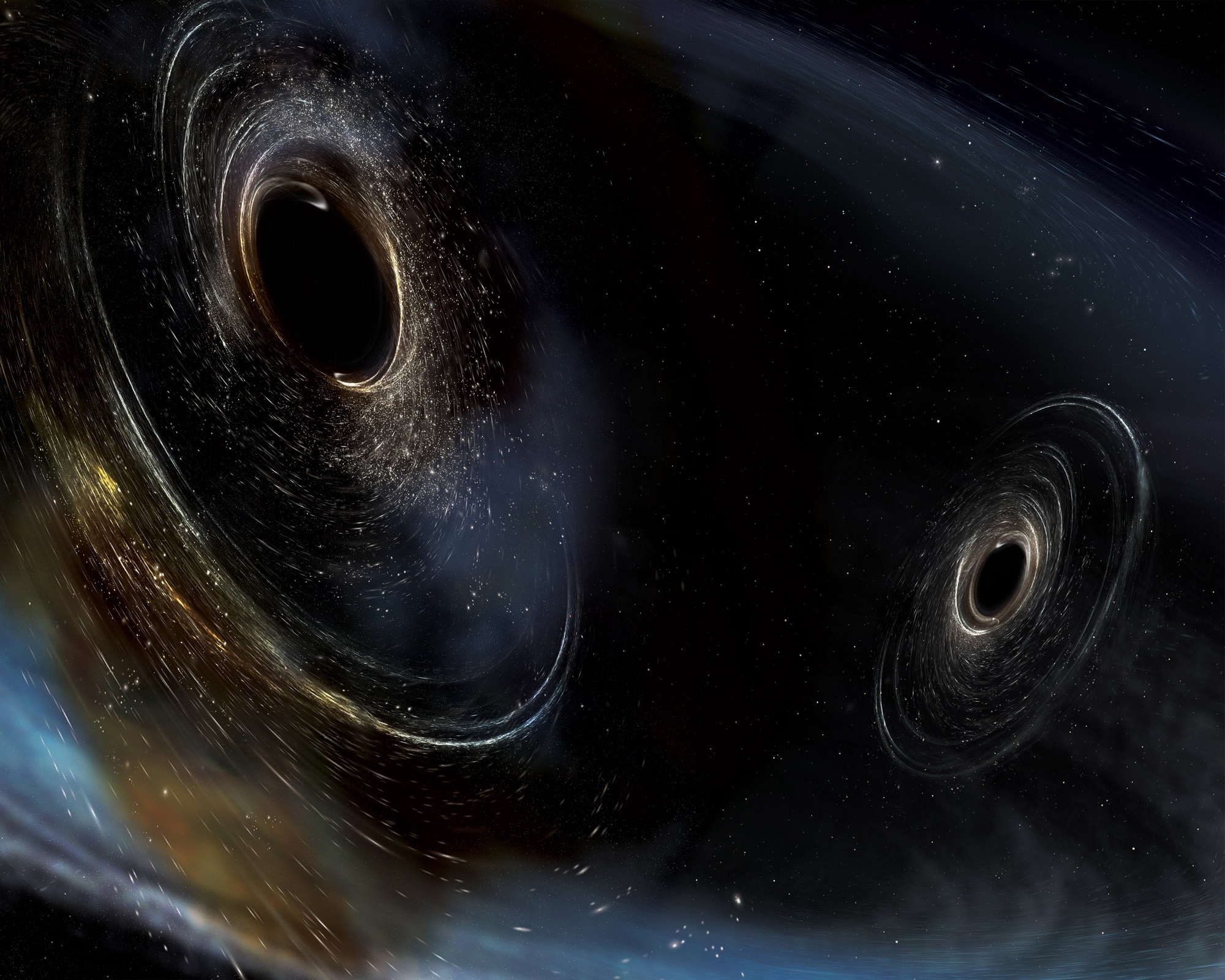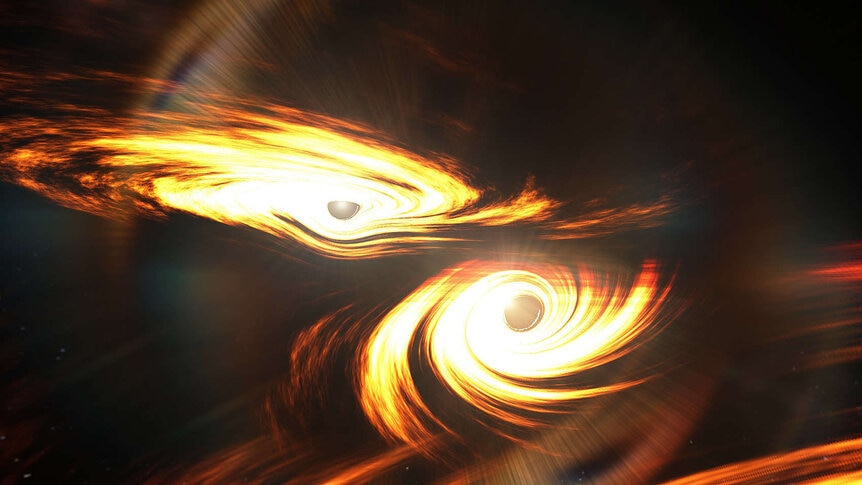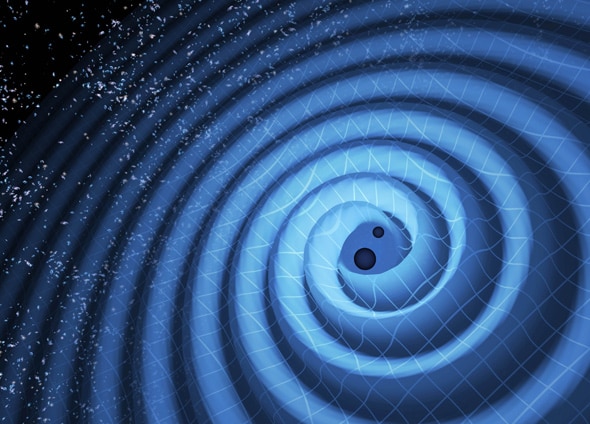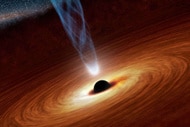Create a free profile to get unlimited access to exclusive videos, sweepstakes, and more!
Was GW190521 the result of eccentric, non-aligned black holes merging?
New analysis of a big merger yields strange results.

On May 21, 2019, a ripple in the fabric of spacetime swept over Earth at the speed of light.
These pass through us all the time, but this one was strong enough to warp space noticeably, at least to the detectors used by the LIGO/Virgo collaboration. As the waves passed, they compressed and rarefied a set of lasers beams, causing their lengths to change by a tiny, tiny amount: About 1/1000th the size of a proton. But it was enough.
The detectors sensed it, and the software monitoring them set off an alarm. Astronomers were alerted, and were able to measure the shape of these gravitational waves as they passed through the detectors. They determined that the waves were caused by two black holes merging. And not just any black holes, but ones with a whopping 66 and 85 times the Sun's mass, the largest such merger ever detected. When the collision was done, a 142 solar mass black hole remained, the excess mass converted to energy, creating the gravitational ripples in spacetime predicted to occur by Einstein over a century ago.
Astronomers dubbed the event GW19051.
It's a mystery how the two black holes had such large masses; perhaps they themselves were the product of lower mass black holes merging. But another mystery still remains: How did they merge?
Gravitational waves are literal waves of spacetime itself, like the fabric of a flag rippling in the wind. They are generated when a mass is accelerated, and the waves are stronger and sharper if the object is very massive, small, and accelerated hard. So two black holes orbiting each other make the perfect gravitational wave generator.
The standard scenario for a merger starts with two black holes orbiting each other. The emitted gravitational waves are weak at first as the black holes orbit at some distance from each other. If the orbit starts off elliptical the emission of these waves will tend to circularize it. Not only that but the waves steal orbital energy from the two, and they slowly approach each other over eons, accelerating faster and faster, so shortly before they merge they're whirling madly around each other in a circular orbit at nearly the speed of light. In the last few seconds they blast out gravitational waves right up to and even momentarily after they collide and merge to form a single, bigger black hole.
But what if that's not always the case? Can two black holes still be on an elliptical path even at the time of the merger? If so, how would that happen?
Which brings us back to GW190521. A team of astronomers has used extensive modeling of GW190521, and they do think it came from an elliptical merger, one noticeably non-circular. If so, this could be giving us clues about the black holes from before the merger.
The astronomers used a suite of software that simulates black holes mergers. These are extraordinarily complex calculations, involving a careful treatment of General Relativity to determine how the gravitational waves are generated depending on a lot of different parameters of the event: the masses of the black holes, their spin, the final mass of the merged black hole, and more. When it's all done, these are imprinted on the pattern of the wave detected, what's called the waveform. This is then compared to the waveform detected to see which one matches the observations best.
They output around a hundred thousand simulated templates to compare with the waveform of GW190521, and what they found is intriguing indeed: The best fit was one where the orbit was decidedly non-circular: It had an eccentricity of 0.7, making it more like an egg-shape than a circle.
This is very different than the original announcement and subsequent papers published by scientists with LIGO/Virgo. They found the orbit was circular, which affected all the other parameters as well. If the orbit's elliptical, things are different.
For example, instead of disparate masses of 66 and 85 solar masses, the new results yield the same mass for both, around 78 times the Sun's. The total mass of the final black hole post-merger is 155 solar, not 142. The new results yield a larger value for the distance to the merger, too: 8.3 billion light years versus 6.2 billion.
So if the orbit was elliptical we see different results. But why was the orbit non-circular?
They posit the black holes were in a crowded environment, like near the center of a galaxy or in a tightly packed globular cluster of stars. Encounters with stars or other black holes can give a kick to the black holes that knocks their orbit askew, leaving it elliptical. In fact that might also explain how these black holes got to such high mass — they had several previous encounters before the merger such that each grew larger until they met.
The simulations also show the black holes had spins that didn't align — in other words, their north poles pointed in different directions on the sky. This produces strong effects in the waveform in the final moments before the merger, which the astronomers see in their best-fitting simulations. That too makes sense if these black holes were in a crowded system of some kind. You'd expect their spins to be randomly oriented.
All of this is important because we really don't have a firm grasp on the conditions the black holes are in before they merge. Did they form together in a high-mass binary star system, slowly converging until they ate each other? Were they in a crowded cluster, separate until right before they merged? Were they near a supermassive black hole we think exist in the center of every big galaxy? Did they have time to circularize their orbit, or was it elliptical going in? Were their spins aligned or not?
All of these circumstances change the waveform of the detected merger, and remember, that's all we see. These all happen way too far away for us to get observations of their environments, so the waveform is the only map we have to see how they lived. Simulations like the ones done here help us tease those details out.
Maybe in the near future we'll see an event close enough, and pinpointed in the sky well enough, to get a good look at where the doomed black holes spent their lives. Until then, we have to rely on our knowledge of physics to figure all that out.




























